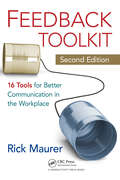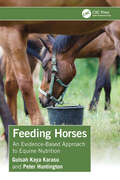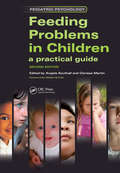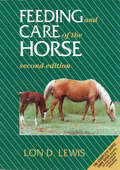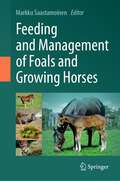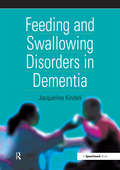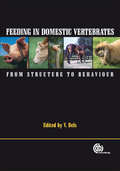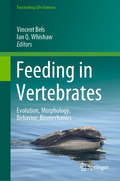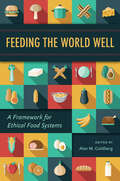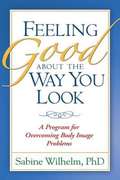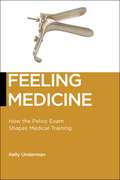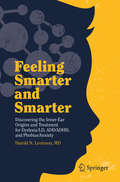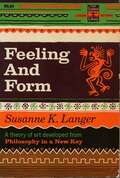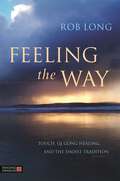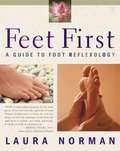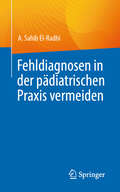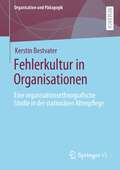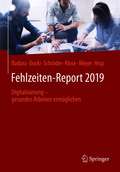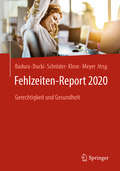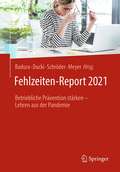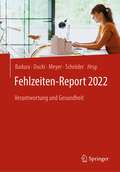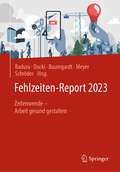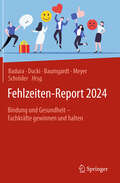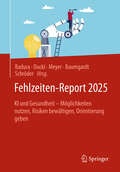- Table View
- List View
Feedback Toolkit: 16 Tools for Better Communication in the Workplace, Second Edition
by Nigel Hooper Rick MaurerThis book provides expert guidance on using feedback as a performance improvement tool. It includes many simple tools readers can use to improve feedback in their work unit. The book suggests that feedback works best when the giver and receiver realize that they are in a dance together.
Feeding Horses: An Evidence-Based Approach to Equine Nutrition
by Gulsah Kaya Karasu Peter HuntingtonThis concise handbook provides evidence-based, practical horse nutrition accessibleto all readers. Standing out from very dense, theoretical and practical horsenutrition books, it arms equine students, veterinary students and horse ownerswith practically applicable information, bringing theory and practice together.At the end of each chapter, veterinarian and equine nutrition experts Dr GulsahKaya Karasu and Dr Peter Huntington provide guidance on practical applications,calculations and the real-life use of information. For example, how is gastric ulcerformation triggered by traditional horse feeding? How can the risk of gastric ulcerformation be reduced with evidence-based feeding?Divided into four parts, the book covers the horse’s digestive system, types offeeds, formulating rations, and nutrition-related health disorders. Its scientificallyvalidated, practical information will be invaluable for horse owners, students andtrainers, equine nutritionists and practitioners within the equine industry.
Feeding Problems in Children: A Practical Guide, Second Edition (Radcliffe Ser.)
by Clarissa Martin Angela SouthallFeeding problems in children are relatively common, and often resolve themselves with little need for intervention. However, some categories of feeding problem are severe, persistent, and may be life-threatening without skilled involvement by professionals, including medical and surgical intervention. This revised and expanded Second Edition of Feeding Problems in Children deals with these severe and persistent problems, summarising the different kinds of work undertaken with children and their families in a number of countries. It first discusses the theoretical frameworks and perspectives, before moving on to explore clinical and applied research aspects of children's feeding. Finally, a comprehensive Clinical Practice Toolkit has been added to this edition, providing clinical models, checklists, model forms and reports. Featuring contributions from well-known international experts in the field, comprehensive and fully referenced, this book continues to be essential reading for all those practising or training in paediatrics in primary or secondary care, including paediatricians, GPs, gastroenterologists, psychologists, psychiatrists, therapists, paediatric nurses, health visitors and allied health professionals. 'Given the multi-cultural composition of today's communities, the decision by Drs Southall and Martin to include a chapter on cultural aspects to feeding was most insightful. This book, with its comprehensive coverage of the issues and a practical Toolkit with examples of materials from a multi-disciplinary practice, makes an essential contribution to the education of frontline clinicians dealing with feeding problems in young children.' - from the Foreword by William B Crist From reviews of the First Edition: 'A detailed guide, extensively referenced' FAMILY MEDICINE 'A useful addition to a hospital library or multi-disciplinary paediatric library' PHYSIOTHERAPY JOURNAL
Feeding and Care of the Horse
by Lon D. LewisThis is the concise, easy-to-use version of Dr. Lewis's Equine Clinical Nutrition, Feeding and Care. It includes a full-color section identifying toxic plants and provides practical information on the diversified effects of different nutrients, feeds and supplements on a horse's athletic performance, reproduction, growth, hooves, appetite, behavior and disease. The book can help prevent common, but expensive problems in horses of all ages.
Feeding and Management of Foals and Growing Horses
by Markku SaastamoinenThis volume offers the latest research-based findings to equip professionals involved in the breeding and raising of horses. Contributions were carefully selected and prepared by leading experts in their fields. The collection starts with a discussion of pregnant and lactating mares, followed by details on foal development, nutritional requirements, and feeding practices under different conditions. Special sections on young horses in training, parasite control as well as on health risks related to nutrition and exercise round off this unique and easy-to-read reference.Today’s horses perform variety of roles and there are many categories of horses based on their breed, size and use, making adequate nutrition challenging. This book considers the links between health, proper dietary treatment and management practices to increase our understanding of the needs of growing horses. In addition, it highlights various innovations in equine nutrition and management to ensure animal wellbeing.Veterinarians, animal nutritionist, and all stakeholders and people working in the horse industry will benefit from the presented knowledge. This book fills a literature gap to prevent health consequences and strengthen performance and physical development in equines.
Feeding and Swallowing Disorders in Dementia
by Jacqueline KindellThis informative manual draws on expert research to highlight the feeding and swallowing difficulties that can occur with dementia. It is also a practical guide that offers potential strategies to manage these problems. Professionals are encouraged to focus on the needs of the individual by providing practical questions that should be asked when making an assessment. This is achieved through a step-by-step process, which allows a worker to observe, document and manage feeding and swallowing difficulties. Forms, schedules and checklists that can be photocopied are provided to aid in implementation. This is a detailed, practical resource which offers support and direction for speech and language therapists, and others with an interest in swallowing problems, working with people with dementia. It includes case studies to illustrate theory in practice, as well as a wide ranging bibliography.
Feeding in Domestic Vertebrates: From Structure to Behaviour
by V. BelsAimed at advanced students and researchers, this volume reviews current knowledge about feeding in domestic vertebrates. Early chapters outline the feeding structures and mechanisms of mammals and birds. Subsequent chapters discuss feeding behavior in particular species, such as chickens, pigs, rabbits, horses, herbivores, ruminants, and even ostriches. Feeding issues relating to free-range poultry and pigs are also addressed. Editor Bels is affiliated with the Muséum National d'Histoire Naturelle in Paris. Distributed in the U. S. by Oxford U. Press. Annotation ©2007 Book News, Inc. , Portland, OR (booknews. com)
Feeding in Vertebrates: Evolution, Morphology, Behavior, Biomechanics (Fascinating Life Sciences)
by Ian Q. Whishaw Vincent BelsThis book provides students and researchers with reviews of biological questions related to the evolution of feeding by vertebrates in aquatic and terrestrial environments. Based on recent technical developments and novel conceptual approaches, the book covers functional questions on trophic behavior in nearly all vertebrate groups including jawless fishes. The book describes mechanisms and theories for understanding the relationships between feeding structure and feeding behavior. Finally, the book demonstrates the importance of adopting an integrative approach to the trophic system in order to understand evolutionary mechanisms across the biodiversity of vertebrates.
Feeding the World Well: A Framework for Ethical Food Systems
by Alan M. GoldbergLeading experts reveal ways that the future of food production for the world's burgeoning population can (and must) be both sustainable and ethical.In the United States, food is abundant and cheap but loaded with hidden costs to the environment, human health, animal welfare, and the people who work in our food systems. The country's current food production systems lack diversity in crops and animals and are intensified but not sustainable, inhumane in the treatment of animals, and inconsiderate of labor. In order to feed the world's rapidly growing population with high-quality, ethically produced food, new food production systems are urgently needed. These new systems must be genetically diverse and environmentally sustainable, and they need to follow internationally recognized animal welfare and labor practices.Feeding the World Well examines these costs of cheap food while presenting a unique framework for ethical food systems: the Core Ethical Commitments, which are designed to guide consumers in choosing foods that are aligned with their values while helping producers enhance the ethics of their practices and products. Edited by Alan M. Goldberg, the volume features contributions from leading ethicists and food systems experts. Addressing complex issues such as climate change, worker exploitation, obesity, antibiotic resistance, wasted food, and biotechnology, the book discusses the fundamental forces that have shaped, and will continue to shape, our food systems. It also describes some of the approaches that food companies and nonprofit organizations are using to address the ethical challenges facing these food systems. Finally, the book explains what the Core Ethical Commitments are (and what they are not), how they were developed, and how they might be used by food system actors.By bringing together an all-star group of contributors from academia and industry, Feeding the World Well sets a new course for food production and how it is evaluated. By including the voices of industry leaders alongside those of researchers and regulators, the book prepares the food production industry for a world in which "ethical" or "sustainable" production practices are not only trendy but necessary to ensure that we can feed the world's growing population. Conceived as a textbook for food studies courses, this volume will appeal to anyone who is strongly interested in food, including conscious consumers, food industry leaders, researchers, and policy makers.Contributors: Anne Barnhill, Martin W. Bloem, Jonathan Bloom, Nicole M. Civita, Claire Davis, Michiel van Dijk, Adele Douglass, Shauna Downs, Kevin Esvelt, Ruth Faden, Jessica Fanzo, Evan Fraser, Maisie Ganzler, Tara Garnett, Sara Glass, Alan M. Goldberg, Christopher Good, Meredith Kaufman, Gillian Kelleher, Frederick L. Kirschenmann, Herman B. W. M. Koëter, Jennifer Kuzma, Kees van Leeuwen, Robert Martin, Anne E. McBride, Suzanne McMillan, Tom Morley, Marion Nestle, Peter O'Driscoll, Lance B. Price, Marie Luise Rau, Bernard Rollin, Yashar Saghai, Susan A. Schneider, Ellen K. Silbergeld, Paul B. Thompson, Paul Willis, Sylvia Wulf
Feeling Good about the Way You Look
by Sabine WilhelmIn a society where a blemish or "bad hair" can ruin an otherwise perfect day and airbrushed abs dominate the magazine rack, many of us feel ashamed of our bodies. If dissatisfaction with your looks is a distressing preoccupation, this compassionate book offers a way to break free from the mirror. Harvard psychologist Sabine Wilhelm leads you through a step-by-step program that helps you fight the urge to spend hours "fixing" your skin and hair, working out, or shopping for flattering clothes. Reality-check exercises based on cognitive-behavioral therapy demonstrate how to identify unfounded beliefs about your appearance. Once you understand the negative thoughts and feelings that distort your self-image, you'll be able to shed lengthy grooming rituals and overcome the embarrassment that keeps you from enjoying life. With Dr. Wilhelm's expert guidance, you'll learn to replace self-doubt and insecurity with confidence and a positive outlook. Whether you've spent thousands on plastic surgery or avoid trips to the beach, dating, or socializing, you owe yourself this opportunity to make peace with your looks. If you or someone you care about is struggling with a body image problem, effective care is finally at hand.
Feeling Medicine: How the Pelvic Exam Shapes Medical Training (Biopolitics #21)
by Kelly UndermanHonorable Mention, Sociology of the Body and Embodiment Best Publication Award, given by the Body and Embodiment Section of the American Sociological AssociationThe emotional and social components of teaching medical students to be good doctorsThe pelvic exam is considered a fundamental procedure for medical students to learn; it is also often the one of the first times where medical students are required to touch a real human being in a professional manner. In Feeling Medicine, Kelly Underman gives us a look inside these gynecological teaching programs, showing how they embody the tension between scientific thought and human emotion in medical education. Drawing on interviews with medical students, faculty, and the people who use their own bodies to teach this exam, Underman offers the first in-depth examination of this essential, but seldom discussed, aspect of medical education. Through studying, teaching, and learning about the pelvic exam, she contrasts the technical and emotional dimensions of learning to be a physician. Ultimately, Feeling Medicine explores what it means to be a good doctor in the twenty-first century, particularly in an era of corporatized healthcare.
Feeling Smarter and Smarter: Discovering the Inner-Ear Origins and Treatment for Dyslexia/LD, ADD/ADHD, and Phobias/Anxiety
by Harold N. Levinson, MDIn this ground-breaking book, Dr. Harold Levinson, a renowned psychiatrist and clinical researcher, provides his long-awaited follow-up work about truly understanding and successfully treating children and adults with many and diverse dyslexia-related disorders such as those found on the cover. This fascinating, life-changing title is primarily about helping children who suffer from varied combinations and severities of previously unexplained inner-ear-determined symptoms resulting in difficulties with: reading, writing, spelling, math, memory, speech, sense of direction and timegrammar, concentration/activity-level, balance and coordinationheadaches, nausea, dizziness, ringing ears, and motion-sickness frustration levels and feeling dumb, ugly, klutzy, phobic, and depressedimpulsivity, cutting class, dropping out of school, and substance abusebullying and being bullied as well as anger and social interactionslater becoming emotionally traumatized and scarred dysfunctional adults Feeling Smarter and Smarter is thus also about and for the millions of frus-trated and failing adults who are often overwhelmed by similar and even more complicated symptoms—as well as for their dedicated healers. Having laid the initial foundations for his many current insights in an earlier bestseller, Smart But Feeling Dumb, Dr. Levinson now presents a compelling range of enlightening new cases and data as well as a large number of highly original discoveries—such as his challenging illumination that all dyslexia-related manifestations are primarily inner-ear or cerebellar-vestibular—not cerebrally—determined and so do not impair IQ, and an “ingeniously simple” explanatory theory of symptom formation. Most important, all the dyslexia/inner-ear based impairments and their symptoms were discovered by Dr. Levinson to respond rapidly and often “mi-raculously” in 75 to 85 percent of cases when treated with simple and safe inner-ear enhancing medications—thus enabling bright but dumb-feeling children and adults to feel… smarter and smarter.
Feeling and Form: A Theory of Art Developed from Philosophy in a New Key
by Susanne K. LangerIn Philosophy in a New Key, Susanne Langer developed a theory of symbolism, there applied to music, which she felt could be developed to embrace all the arts. In Feeling and Form she did just that. It offers the reader nothing less than a systematic, comprehensive theory of art, applied in turn to painting, sculpture, architecture, literature, music, the dance, drama and film.
Feeling the Way: Touch, Qi Gong healing, and the Daoist tradition
by Rob LongThis practical, down-to-earth guide offers the means for you to awaken your healing hands. Focussing on the use of hand sensitivity and energy in healing, the guide introduces methods to rapidly sharpen your latent skills and increase your confidence when feeling and working with Qi. Based on a combination of clinical examples, Daoist philosophy, and detailed 'how-to' instructions, the author shows you how to develop your ability to work energetically with your hands, providing an invaluable, powerful tool for subtle diagnosis and healing work that can supplement other methods.
Feet First: A Guide To Foot Reflexology
by Laura Norman Thomas CowanIn Feet First, America's foremost reflexology spokesperson on radio and TV -- and in publications from The New York Times to Cosmopolitan -- explains how to relieve physical problems -- from headaches and insomnia to high blood pressure and weight loss -- with this easily accessible and popular holistic technique. Showing how everyone can use reflexology to reduce stress, revitalize energy, strengthen the immune system, stimulate creativity, and enhance relationships, Norman also includes: * descriptions of the reflex points, the six basic techniques, and easy-to-learn specialized and master routines. * 32 foot-relaxation techniques, most of them unique to Norman's program * specific chapters and techniques for stress, sports injuries, addiction problems, the terminally ill, women, and couples * visualizations, affirmations, and children's games to use with the routines * a chart of ailments and reflexology aids for them Feet First is the only reflexology guide designed for everyday situations and people -- from office workers on a lunch break to families caring for an aged relative. This special kind of "touch therapy" strengthens the bonds between those who use it together.
Fehldiagnosen in der pädiatrischen Praxis vermeiden
by A. Sahib El-RadhiIn diesem Buch werden die häufigsten Symptome in der Kinder- und Jugendmedizin besprochen. Es basiert auf den besten verfügbaren wissenschaftlichen Erkenntnissen und aktuellen Informationen. Das Werk behandelt auch eine Reihe von häufigen Erkrankungen im Zusammenhang mit bakteriellen und viralen Infektionen der Mund-, Nasen-, Augen-, Brust-, Bauch und des Urogenitalregion. Das Buch hilft dem klinisch Tätigen, Symptome und Anzeichen pädiatrischer Erkrankungen zu unterscheiden, um Diagnosefehler zu vermeiden. Jedes Kapitel beginnt mit einer Liste von Kernaussagen und enthält Tabellen und Abbildungen, um die behandelten Themen zu vertiefen. Der gesamte Text ist sehr leserfreundlich geschrieben. Das Buch ist für Ärztinnen und Ärzte in der Allgemeinpädiatrie und für hausärztlich Tätige von Interesse. Darüber hinaus ist es für Studierende relevant, für Pflegekräfte und für alle anderen Fachpersonen, die Kinder versorgen.Die Übersetzung wurde mit Hilfe von künstlicher Intelligenzdurchgeführt. Eine anschließende menschliche Überarbeitung erfolgte vor allem in Bezug auf den Inhalt.
Fehler im Griff: Fehlleistungen begreifen. Fehlertypen unterscheiden. Fehlerursachen vermeiden.
by Martin SauerlandDieses Buch enthält alles, was Sie über Fehler, Fehlerursachen, vor allem aber über die Möglichkeiten der Vermeidung von Fehlern bei typischen Bürotätigkeiten wissen müssen. Sie kennen es (natürlich nur vom Hörensagen): Die Originalvorlage im Kopierer liegen lassen, eine E-Mail ohne den erforderlichen Anhang versenden, eine vertrauliche Nachricht falsch adressieren, eine Rechnung über 17683 € statt über 17863 € ausstellen oder eine Stelle mit einer inkompetenten Person besetzen – menschliche Fehlleistungen sind ärgerlich, zumeist auch peinlich, zuweilen auch enorm kostspielig. Im Rahmen zahlreicher wissenschaftlicher Analysen sind wir den Häufigkeiten, Typen, Ursachen und Bewältigungsmöglichkeiten solcher Heimsuchungen auf den Grund gegangen. Die Befunde werden auf beispielhafte, anschauliche und amüsante Weise vorgestellt. Der Fokus liegt dabei auf den tieferliegenden motivationalen Fehlerursachen. Die Berücksichtigung dieser energetischen Komponente ermöglicht es nämlich, neue und wirkmächtige Strategien zur Vermeidung von Fehlern in einer immer komplexer und dynamischer werdenden Arbeitswelt zu entwickeln. Die entsprechenden Methoden können von Mitarbeitenden und Führungskräften niedrigschwellig, unmittelbar und selbstgesteuert angewendet werden. Vielleicht ist es durch authentisch-motiviertes Handeln sogar möglich, so etwas wie subjektiv erlebte Fehlerfreiheit zu erreichen. Doch lesen Sie selbst! Zum Autor: Dr. Martin Sauerland, Professor für Arbeit und Organisation an der Hochschule für öffentliche Verwaltung und Finanzen in Ludwigsburg.
Fehlerkultur in Organisationen: Eine organisationsethnografische Studie in der stationären Altenpflege (Organisation und Pädagogik #33)
by Kerstin BestvaterIm Zentrum dieser Studie steht die Frage nach der Verflechtung der Fehlerkultur mit den Entscheidungs- und Handlungspraktiken in einer Alten- und Pflegeeinrichtung. Dafür wurde mit der pädagogischen Organisationsethnografie ein explorativer Zugang zum Forschungsgegenstand gewählt, der einen tiefen Einblick in die soziale Welt der Altenpflege gewährt. Kernstück ist eine konzeptualisierende Darstellung feldtypischer Praktiken und eine gegenstandsbezogene Theorieentwicklung, die im Sinne der Grounded Theory umgesetzt wurde. Das genuine Dilemma der Altenpflege zwischen Wirtschaftlichkeit und Pflegeethos führt zu Praxismustern, die als Problemlösungsstrategien auch die Fehlerkultur prägen.
Fehlzeiten-Report 2019: Digitalisierung - gesundes Arbeiten ermöglichen (Fehlzeiten-Report #2019)
by Antje Ducki Helmut Schröder Bernhard Badura Joachim Klose Markus MeyerZahlen, Daten, Analysen aus allen Branchen der WirtschaftDer Fehlzeiten-Report, der jährlich als Buch erscheint, informiert umfassend über die Struktur und Entwicklung des Krankenstandes der Beschäftigten in der deutschen Wirtschaft und beleuchtet dabei detailliert einzelne Branchen. Der vorliegende Fehlzeiten-Report zeigt Facetten des Themas „Digitalisierung – gesundes Arbeiten ermöglichen“ aus gesellschaftlicher, unternehmerischer und individueller Perspektive auf. Neben Praxisbeispielen werden auch digitale Anwendungen, die im Rahmen des Betrieblichen Gesundheitsmanagements zum Einsatz kommen können, vorgestellt. 26 Fachbeiträge diskutieren u. a. folgende Fragen: Welche Chancen und Risiken ergeben sich durch die Digitalisierung für die Arbeitswelt und für die Gesundheit der Beschäftigten? Wie kann entgrenztes Arbeiten gesundheitsgerecht gestaltet werden? Welche Herausforderungen und Chancen ergeben sich zukünftig für das Betriebliche Gesundheitsmanagement?Darüber hinaus ist der Report durch umfassende Daten und Analysen ein wertvoller Ratgeber für alle, die Verantwortung für den Arbeits- und Gesundheitsschutz in Unternehmen tragen.
Fehlzeiten-Report 2020: Gerechtigkeit und Gesundheit (Fehlzeiten-Report #2020)
by Antje Ducki Helmut Schröder Bernhard Badura Joachim Klose Markus MeyerZahlen, Daten, Analysen aus allen Branchen der WirtschaftDer Fehlzeiten-Report, der jährlich als Buch erscheint, informiert umfassend über die Struktur und Entwicklung des Krankenstandes der Beschäftigten in der deutschen Wirtschaft und analysiert dabei detailliert einzelne Branchen. Der aktuelle Fehlzeiten-Report widmet sich dem Thema „Gerechtigkeit und Gesundheit“ und berücksichtigt dabei neben gesellschaftlichen und unternehmerischen auch individuelle Blickwinkel: 20 Fachbeiträge zeigen vielschichtige Perspektiven auf und diskutieren u. a.: Was ist eigentlich Gerechtigkeit und wie kann Arbeit gerecht gestaltet werden? Was heißt gerechtes Handeln in Unternehmen ganz konkret? Welche Anforderungen haben Beschäftigte an eine gerechte Führungskraft? Und was sind die gesundheitlichen Folgen, wenn sich Beschäftigte subjektiv ungerecht behandelt fühlen? Welchen Beitrag kann das Betriebliche Gesundheitsmanagement leisten, wenn es um Fragen der Gerechtigkeit geht?Im umfangreich erweiterten Kapitel "Daten und Analysen" liefern zahlreiche Beiträge fundierte Antworten – u.a. zur Aussagekraft der Kennzahl „Fehlzeiten“, zur Bedeutung psychischer Erkrankungen für Beschäftigte und Betriebe, zum Arbeitsunfallgeschehen, Krankengeld und Erwerbsminderungsrente – für alle, die Verantwortung für den Arbeits- und Gesundheitsschutz in Unternehmen tragen.
Fehlzeiten-Report 2021: Betriebliche Prävention stärken – Lehren aus der Pandemie (Fehlzeiten-Report #2021)
by Antje Ducki Helmut Schröder Bernhard Badura Markus MeyerZahlen, Daten, Analysen aus allen Branchen der WirtschaftDer Fehlzeiten-Report, der jährlich als Buch erscheint, informiert umfassend über die Struktur und Entwicklung des Krankenstandes der Beschäftigten in der deutschen Wirtschaft und beleuchtet dabei detailliert einzelne Branchen. Der aktuelle Report möchte wissenschaftlich fundiert „Betriebliche Prävention stärken“ und diskutiert, welche „Lehren aus der Pandemie“ Unternehmen und Beschäftigte ziehen können. Der vorliegende Fehlzeiten-Report umfasst 26 Fachbeiträge und richtet den Blick auf die Historie und fragt auch nach zukünftigen gesundheitlichen Bedrohungen für Gesellschaft und Wirtschaft und damit einhergehenden Herausforderungen für gesundes Arbeiten thematisiert Folgen der pandemiebedingten Maßnahmen für die Gesellschaft und insbesondere für die Arbeitswelt gibt Antworten auf die Frage, wie Gesellschaft und Wirtschaft mit der Krise umgegangen sind und was Beschäftigte und Unternehmen aus der Krise lernen können zeigt auf, welchen Beitrag das Betriebliche Gesundheitsmanagement leisten kann, damit Unternehmen und Beschäftigte idealerweise gestärkt aus dieser Krise hervorgehen. In gewohnter Qualität liefern fünf weitere Beiträge im Kapitel Daten und Analysen darüber hinaus fundierte Antworten für alle, die Verantwortung für den Arbeits- und Gesundheitsschutz in Unternehmen tragen.
Fehlzeiten-Report 2022: Verantwortung und Gesundheit (Fehlzeiten-Report #2022)
by Antje Ducki Helmut Schröder Bernhard Badura Markus MeyerZahlen, Daten, Analysen aus allen Branchen der WirtschaftDer jährlich als Buch erscheinende Fehlzeiten-Report informiert umfassend über Strukturen und Entwicklungen des Krankenstandes von Beschäftigten der deutschen Wirtschaft und beleuchtet dabei einzelne Branchen detailliert. Der diesjährige Schwerpunkt liegt auf der Unternehmensverantwortung bezüglich ihrer ökonomischen, ökologischen und sozialen Rolle für die Gesellschaft in einer von tiefgreifenden Krisen und Transformationsprozessen geprägten Zeit.Der Fehlzeiten-Report 2022 erörtert wissenschaftlich fundiert u. a.die Notwendigkeit einer multiplen, ebenenübergreifenden Verantwortungsübernahmedie Bedeutung von Nachhaltigkeitsmanagement für Unternehmenwie gesellschaftlich verantwortungsvolles Handeln mit der Arbeitszufriedenheit und der Gesundheit der Beschäftigten in Zeiten mobiler und hybrider Arbeit zusammenhängtwas es bedeutet, wenn „Gesundheit“ in den unternehmerischen Wertekanon aufgenommen und in unternehmerische Prozesse und Abläufe integriert wirdwelchen Nutzen und welches Potenzial das Thema Verantwortung für das Betriebliche Gesundheitsmanagement birgtIn gewohnter Qualität liefert die Rubrik Daten und Analysen darüber hinaus Informationen für alle, die Verantwortung für den Arbeits- und Gesundheitsschutz in Unternehmen tragen.
Fehlzeiten-Report 2023: Zeitenwende – Arbeit gesund gestalten (Fehlzeiten-Report #2023)
by Antje Ducki Helmut Schröder Bernhard Badura Markus Meyer Johanna BaumgardtZahlen, Daten, Analysen aus allen Branchen der Wirtschaft - Der jährlich als Buch erscheinende Fehlzeiten-Report informiert umfassend über Strukturen und Entwicklungen des Krankenstandes von Beschäftigten der deutschen Wirtschaft und beleuchtet dabei einzelne Branchen detailliert. Das diesjährige Schwerpunktthema ist "Zeitenwende gesund und nachhaltig gestalten".In gewohnter Qualität liefert die Rubrik Daten und Analysen darüber hinaus Informationen für alle, die Verantwortung für den Arbeits- und Gesundheitsschutz in Unternehmen tragen.
Fehlzeiten-Report 2024: Bindung und Gesundheit - Fachkräfte gewinnen und halten (Fehlzeiten-Report #2024)
by Antje Ducki Helmut Schröder Bernhard Badura Markus Meyer Johanna BaumgardtZahlen, Daten, Analysen aus allen Branchen der Wirtschaft - Der jährlich als Buch erscheinende Fehlzeiten-Report informiert umfassend über Strukturen und Entwicklungen des Krankenstandes von Beschäftigten der deutschen Wirtschaft und beleuchtet dabei einzelne Branchen detailliert. Das diesjährige Schwerpunktthema ist "Bindung und Gesundheit - Fachkräfte gewinnen und halten".In gewohnter Qualität liefert die Rubrik Daten und Analysen darüber hinaus Informationen für alle, die Verantwortung für den Arbeits- und Gesundheitsschutz in Unternehmen tragen.
Fehlzeiten-Report 2025: KI und Gesundheit - Möglichkeiten nutzen, Risiken bewältigen, Orientierung geben (Fehlzeiten-Report #Volume)
by Antje Ducki Helmut Schröder Bernhard Badura Markus Meyer Johanna BaumgardtDer jährlich erscheinende Fehlzeiten-Report informiert umfassend über die Entwicklung des Krankenstandes von Beschäftigten in Deutschland. Neben detaillierten Sekundäranalysen von Versichertendaten werden empirische Studienergebnisse, zeitgemäße methodische Herangehensweisen und Leuchtturmprojekte der betrieblichen Gesundheitsförderung vorgestellt. Vor dem Hintergrund aktueller technischer Entwicklungen beleuchtet der Fehlzeiten-Report 2025 schwerpunktmäßig Chancen und Herausforderungen des Einsatzes von Künstlicher Intelligenz (KI) in der Arbeitswelt. Er bietet einen orientierenden Überblick zu den Auswirkungen des Einsatzes von KI auf die betriebliche Gesundheitsförderung, Arbeitsumgebungen, Führung und die Gesundheit von Beschäftigten. Aus unterschiedlichen Perspektiven werden dabei u.a folgende Fragen erörtert: Wie kann KI so zum Einsatz gebracht werden, dass die menschlichen Fähigkeiten erweitert und gleichzeitig die Gesundheit der Beschäftigten sowie die individuelle Privatsphäre geschützt werden? Wie gelingt die Entwicklung von KI-Systemen, in denen Mensch und Maschine produktiv zusammenarbeiten? Welche wissenschaftlich fundierten Lösungsansätze zum menschen- und gesundheitszentrierten Umgang mit KI gibt es im Arbeitsschutz und der betrieblichen Gesundheitsförderung? Darüber hinaus liefert der Fehlzeiten-Report 2025 in gewohnter Qualität Daten und Analysen zu Fehlzeiten von Beschäftigten in Deutschland: Aktuelle Statistiken zum Krankenstand in allen Branchen Vergleichende Analysen nach Berufsgruppen, Bundesländern und Städten Die wichtigsten für Arbeitsunfähigkeit verantwortlichen Krankheitsarten Detaillierte Auswertungen u.a. zu Arbeitsunfällen, Langzeitarbeitsunfähigkeit, Burnout und Kinderkrankengeld Zudem gibt es vor dem Hintergrund der aktuellen Diskussion um hohe Fehlzeiten einen Beitrag zur Einführung von Karenztagen und möglichen Effekten einer Absenkung der Lohnersatzrate. Der Fehlzeiten-Report wird vom Wissenschaftlichen Institut der AOK (WIdO) in Kooperation mit der Universität Bielefeld und der Berliner Hochschule für Technik herausgegeben.
